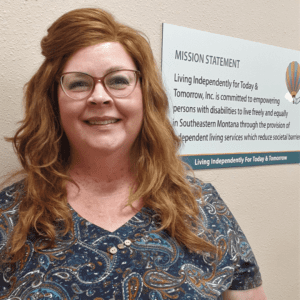This is another post in a series we are calling “Wednesday Wisdom” Where we take you, our consumers, supporters, and readers inside of LIFTT to give a detailed picture of some portion of our programs and operations. This week, CFC/SDPAS PCA Program Facilitator Valerie Rowlison takes readers on a step-by-step journey through the process by which a new consumer comes on to LIFTT’s CFC/SDPAS PCA program’s services.
The CFC/SDPAS Intake Process
by
Valerie Rowlison
LIFTT CFC/SDPAS PCA Program Facilitator

LIFTT CFC/SDPAS PCA Program Facilitator Valerie Rowlison
By “intake process” I mean the well-defined method by which a person becomes a consumer of LIFTT’s PCA Program and begins to receive CFC/SDPAS services (Community First Choice/ Self Direct Personal Assistance Services). The intake process is the bridge between the Consumer/Personal Representative (PR), Personal Care Assistant (PCA), and LIFTT. In many ways, my paper is a continuation of what Lanette Brown wrote in “What qualifies a person to become a consumer of the PCA program or CFC/SDPAS program?” presented and posted on January 3, 2023.
Once LIFTT’s PCA Program receives the consumer’s profile from Mountain-Pacific Quality Health – MPQH1, LIFTT has ten (10) calendar days to complete the intake and start the CFC/SDPAS services observing the list of tasks authorized by the MPQH nurse.
The PCA Facilitator will then call the consumer/PR and inform them what specific CFC/SDPAS PCA tasks have been authorized by the MPQH nurse and schedule an appointment to complete the intake. Until the COVID-19 Public Health Emergency (PHE) is terminated the intake process can be completed over the phone, at home, or at LIFTT’s office. The preferred place for the intake is the consumer’s home because it will allow the PCA Facilitator to observe the home environment and its safety, as well as the existence of barriers that need to be removed by ramps, accessible bathrooms, toilet lifts, Hoyer lifts, etc. The consumer is also more at ease when they are in their home environment.
The PCA Facilitator will gather the forms required to complete the intake (packet), and fills them out using all the information received during the referral process with as much detail as possible. When the packet is mailed, the PCA Facilitator will mark each form with sticky notes containing explanations and indicating where the Consumer/PR should sign, what copy to keep and what copy to return to LIFTT.
We have a red folder because the color makes it easier to identify the folders that correspond to intake processes. This red folder will store all the PCA applications, along with blank Service Delivery Record (SDR) forms. The state of Montana is planning to implement what is called Electronic Visit Verification (EVV) around October 2023. The EVVs will replace the SDRs and extinguish the red folder because all the records will be kept electronically.
A blue folder containing copies of all the Consumer/PR paperwork is given to them during the intake process. The Consumer/PR will keep this blue folder at home and use it to continue to file additional paperwork. Both the red and blue folders will have copies of forms that have been signed and dated before services begin.
Among the mandatory forms that LIFTT’s PCA Program obtains from Consumer/PR are the following:
- Form SLTC-160 – The Health Care Professional Authorization Form which the doctor must sign/date, and fax to LIFTT before the CFC/SDPAS services can begin.
- Agency List- list of service agencies that consumers may currently or recently receive services with.
- Media release (optional)
- Solicitation (Statement they contacted and initiated services on their own accord)
- Form SLTC-159 – Member/personal representative agreement
- LIFTT policies and procedures book
- Hospitalization policy
- Member/Client Fraud policy
- Consumer Rights and Appeals Process
- Safety Policy Statement
- Acknowledgment page
- HIPPA (Health Insurance Privacy and Portability Act)
- Waiver and release form
- Backup plan and information
- Form SLTC-200 – Person Centered Planning (PCP) form (completed by the Plan facilitator if that is not the LIFTT facilitator.)
- A sheet explaining what a unit is
- Form SLTC-155 -Copy of MPQH profile
- Form SLTC 175- Service plan
- Current Payroll Schedule
- Sample SDRs (SDR, Shopping and Community Integration Mileage Record, Medical Escort Form)
- Sample Medical escort appointment verification
- List of what Medicaid requires us to have if we are paying PCA to assist at a medical appointment
- ER/Outpatient procedures/Hospitalization
- Form SLTC 210- Recertification Document
- Education Checklist
- Give Consumer information on:
- Quick reference guide
- Acronyms List
- SDR tip sheet
- SDR Timesheets- outline of how to send SDR by email
- Abuse and neglect information
- The PCA application for employment must be completed and include copies of at least 2 forms of identification (ID), to comply with the requirement of the United States Citizenship and Immigration Services (USCIS) I-9 form. For those Consumers who will receive transportation services, a copy of the PCA’s driver’s license and car insurance is mandatory.
If the intake process takes longer than ten (10) days LIFTT must present a justification to MPQH explaining the reasons for the delay. Unfortunately, delays happen often and they are caused by incomplete applications, LIFTT not receiving the signed Health Care Professional Authorization timely, or delays in mail delivery.
Once everything is returned and in hand, the Consumer/PR is notified they can start documenting services on the SDRs/Timesheets. LIFTT faxes Form SLTC-163 known as Agency Admit Sheet (AAS) to MPQH which gives the information about the intake date, start date, and Consumer diagnosis.
Once the intake is completed, the LIFTT’s PCA Facilitator completes the opening statement and writes a case note summarizing the intake meeting called “intake statement,” completing the CIL Suite entry for disability, goals. services, and programs. All the forms are scanned into the CIL Suite document center. A file is established, and the hard copy forms are kept there for as long as the consumer is active.
The time necessary to gather, prefill and prepare for intake is approximately an average of 2 hours, however, the completion of an intake from start to finish may consume up to six (6) hours.
Case noting each step of the process is crucial. As we all know, if it’s not documented it did not happen. Once the intake is completed, the Consumer is added to the caseload and is required to participate in a recertification process at six months and the annual review each year.
